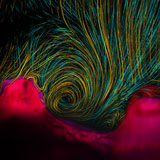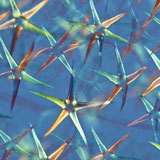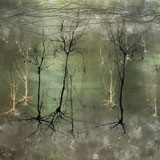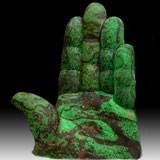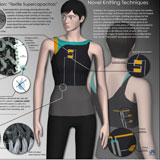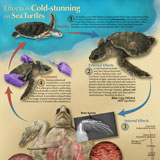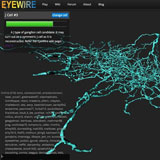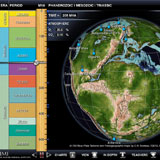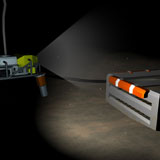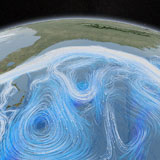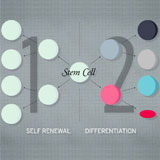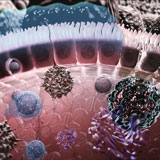
VISUALIZATION CHALLENGE
2013 Winners
Captions from Mark Peplow, Science 343:599-610(2014). Full story in Science magazine.
Photography
First Place
Invisible Coral Flows
Vicente I. Fernandez, Orr H. Shapiro, Melissa S. Garren, Assaf Vardi and Roman Stocker, Massachusetts Institute of Technology
Invisible Coral Flows reveal the hidden flow generated by small hairs (cilia) covering the surface of the coral, between two coral polyps that are 3 mm apart. Two shots taken 1.5 hours apart are combined into a single image, showing how the coral is able to create a long-lasting whirlpool structure that alters the local environment and enhances the coral's ability to "breathe."
Honorable Mention
Stellate leaf hairs on Deutzia scabra
Stephen Francis Lowry, Steve Lowry Photography
These exuberant starbursts shoot from the leaves of Deutzia scabra, a deciduous shrub sometimes known as "Pride of Rochester." Its leaves are covered with tiny hairs tipped by stars a quarter-millimeter across, giving it a fuzzy texture that Japanese woodworkers sometimes use for fine polishing.
People's Choice
Polymer Micro-structure Self-assembly
Anna Pyayt and Howard Kaplan, University of South Florida
This image demonstrates results of the study of micro-structure formation in polymers that self-assemble into different shapes ranging from grains to lines interconnected into complex patterns and meshes. It shows the microstructure of a 2-millimeter-long fragment of self-assembled polymers, which University of South Florida materials scientist Anna Pyayt is using to build miniature "lab-on-a-chip" devices for biomedical diagnostic applications.
Illustration
First Place
Cortex in Metallic Pastels
Greg Dunn, Greg Dunn Design
Cortex in Metallic Pastels represents a stylized section of the cerebral cortex, in which axons, dendrites, and other features create a scene reminiscent of a copse of silver birch at twilight. An accurate depiction of a slice of cerebral cortex would be a confusing mess, says illustrator Greg Dunn, so he thins out the forest of cells, revealing the delicate branching structure of each neuron. Dunn combined his background in neuroscience and his love of Asian art, to create the sparse, striking illustrations of the brain.
Honorable Mention
Security Blanket
Lorrie Faith Cranor, Carnegie Mellon University
Security Blanket displays a multicolored "word cloud" of the 1000 most common passwords in the social gaming website, RockYou. The passwords were sized according to their frequency and colored according to their theme. The most common--"123456"--was chosen by three times as many people as the next most popular password.
People's Choice
Human Hand Controlling Bacterial Biofilms
Lydia-Marie Joubert, Stanford University
In our war against bacteria, the microbes are winning. That somber message is writ large in this image of a human hand covered with Pseudomonas bacteria. Those colored green are resistant to antimicrobial treatment--only a rare few are red, indicating that they have been vanquished.
Posters & Graphics
First Place and People's Choice
Wearable Power
Kristy Jost, Babak Anasori, Majid Beidaghi, Genevieve Dion and Yuri Gogotsi, Drexel University
Wearable Power conveys a new science and design concept for engineering materials for smart textiles. The end product shown on the model demonstrates the technical details of the knitted fabrics, and this 3-D-rendered garment can be sent to a computerized knitting machine and made within minutes. This approach bridges the gap between lab scale researchers, clothing designers and industrial manufacturers, and can have immediate applications in the medical, military and sportswear industries.
Honorable Mention
Life Cycle of a Bubble Cluster: Insight from Mathematics, Algorithms and Supercomputers
RobertI. Saye and James A. Sethian, UC Berkeley and Lawrence Berkeley National Laboratory
Soap bubbles are often perceived as majestic, but the physics of popping bubbles in a foam are far from simplistic. Delving into the multi-scale phenomena underpinning bubble dynamics, one finds that there is host of challenges that need to be solved if one is to model and simulate foam behavior with computers. This poster tells part of this story, from the picturesque behavior of soap bubbles, to multi-scale physics and mathematical modeling, to simulation with powerful supercomputers.
Honorable Mention
Effects of Cold-stunning on Sea Turtles
Katelyn McDonald and Timothy Phelps, Johns Hopkins University; Jennifer Dittmar, The National Aquarium
The poster describes the physiological changes that lead to cold-stunning in a series of beautiful anatomical illustrations that were all based on medical images, but were drawn and assembled using computer design software. It also shows how to identify a cold-stunned turtle and provides the number of a turtle stranding hotline.
Games & Apps
First Place
EyeWire: A Game to Map the Brain
Amy Robinson, William Silversmith, Matthew Balkam, Mark Richardson, Sebastian Seung, and Jinseop Kim, EyeWire
EyeWire is one of the fastest growing citizen science projects ever created. The game presents players with micrographs that show the neurons in a mouse's retina. The goal is to distinguish the twists and turns of a particular neuron in 3-D, in order to build up a complete map of the complex connections involved in vision.
Honorable Mention
EarthViewer
Mark Nielsen and Satoshi Amagai, Howard Hughes Medical Institute; Michael Clark, EarthBuzz Software, Ltd.; Blake Porch and Dennis Liu, Howard Hughes Medical Institute
EarthViewer is an iPad app that puts our planet's deep history at your fingertips. You can scroll through billions of years in a few seconds, watching how continents shift and how changes in solar luminosity, atmospheric composition, and climate interact. Designed as a classroom tool, students can use the app not only to see when and where key geological events took place, but also to learn about the Earth at those instances.
Honorable Mention
Deep-sea Extreme Environment Pilot (DEEP)
Daniel Rohrlick, Eric Simms, Cheryl Peach, Debi Kilb, Scripps Institution of Oceanography, University of California, San Diego; Charina Cain, Birch Aquarium at Scripps Institution of Oceanography
DEEP is an educational game that allows users to pilot a Remotely Operated Vehicle (ROV) to explore the deep ocean. Game features include exploring hydrothermal vent environments, maintaining an ocean observatory, and examining strange and unique organisms that survive in the harsh deep-sea habitat. Educators at the Scripps Institution of Oceanography developed the interactive game to inspire middle school pupils but acknowledge that its appeal is not limited to schoolchildren.
People's Choice
Meta!Blast: The Leaf
Eve Syrkin Wurtele, William Schneller, Paul Klippel, Greg Hanes, Andrew Navratil and Diane Bassham, Iowa State University
Meta!Blast: The Leaf is a game that immerses the player on and in a leaf. Intended as a supplement to in-class instruction, it lets high school students pilot a miniature bioship across a strange landscape, which features nematodes and a lumbering tardigrade. They can dive into individual cells and zoom around a chloroplast, activating photosynthesis with their ships search lamp. By conveying the complexity and visual interest of a biological system, Eve Wurtele and her team seek to increase student engagement with science and encourage a strong foundation in STEM.
Video
First Place
Dynamic Earth Visualization Excerpt: Coronal Mass Ejection and Ocean/Wind Circulation
Greg Shirah and Horace Mitchell, NASA/Goddard Space Flight Center; Tom Bridgman, Global Science & Technology, Inc.
The video segment, Coronal Mass Ejection and Ocean/Wind Circulation, is part of a longer film called Dynamic Earth: Exploring Earth's Climate Engine that has played to audiences in planetaria around the world.
The segment used real satellite data and six computational models to create a vision that is both beautiful and scientifically accurate. Its long, swooping scenes reveal how different parts of the climate system interact at very different scales.
"It's one of the top visualizations we've ever done," says Horace Mitchell, who leads NASA's Scientific Visualization Studio.
Honorable Mention
StemCellShorts
Ben Paylor, Mike Long, Jim Till, Janet Rossant, Mick Bhatia, David Murawsky and James Wallace, Stem Cell Network
StemCellShorts is a series of succinct, animated videos that introduce basic concepts in stem cell research. Each of the 1-minute videos answers a simple question about stem cells and is narrated by eminent scientists. The team, Ben Paylor at the University of British Columbia and Michael Long at the University of Toronto, is now expanding the series to cover adult and cancer stem cells, as well as ethical issues surrounding stem cell research. They hope that it will help foster informed public dialogue about the implications and future of the work.
Honorable Mention
Immunology of the Gut Mucosa
Doug Huff and Elizabeth Anderson, Arkitek Studios; Zoltan Fehervari, Nature Immunology; Simon Fenwick, Nature Reviews
This 3-D animation explores the role of the gut mucosa in the immune response, how it protects the individual against food-borne pathogens, and what happens when the system gets out of whack. It illuminates the inner workings of the gut mucosa as a defense mechanism for the body, to provide people with a greater appreciation for the complex processes involved, as well as a better understanding of why food-borne allergies occur.
Honorable Mention
Visualizing Leaf Cells From Within
Geoffrey J. Harlow, Shou Li, Albert C. Cruz, Jisheng Chen and Zhenbiao Yang, University of California, Riverside
Visualizing Leaf Cells from Within presents leaf cells simply and naturally, in bright orange, yellow, and red colors, and it provides viewers with basic knowledge of the pavement cell system. To clearly show the 3-D shape of pavement cells and their unique interlocking morphology, Geoffrey Harlow and Albert Cruz at the University of California, Riverside, utilized a z-stack video and a rotating 3-D image. The end result: a visually appealing look at pavement cells from every angle.
People's Choice
Spherical Nucleic Acids
Quintin Anderson, The Seagull Company; Chad Mirkin and Sarah Petrosko, Northwestern University
The floating golden sphere, bristling with corkscrew strands of RNA, drifts majestically toward the jostling lipid bilayer that surrounds a cell. Slowly, gently, it squeezes through the layer until it is inside the cell. Breezing across cell membranes is just one talent of these spherical nucleic acids (SNAs) developed by nanotechnology pioneer Chad Mirkin at Northwestern University and explained in the video created by Quintin Anderson of the scientific animation firm, The Seagull Company. The objective is to give the audience an overview of how the properties of SNAs make them favorable for therapeutic treatments and medical diagnostics.



